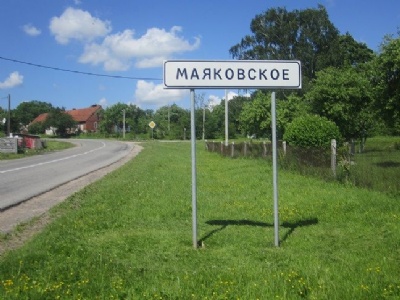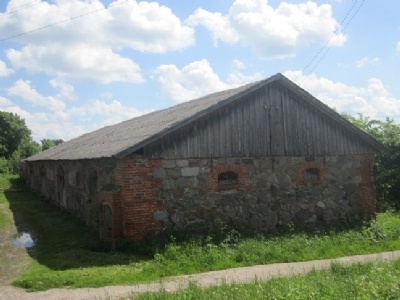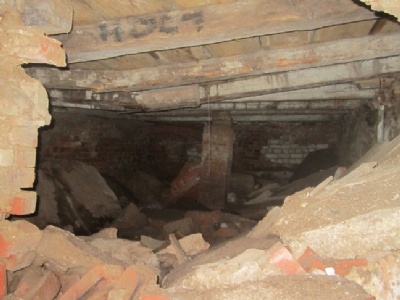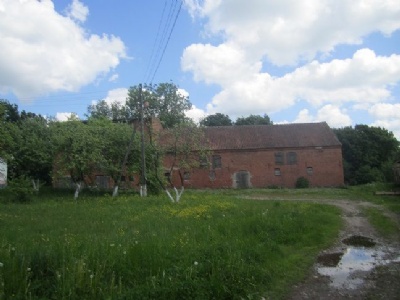Nemmersdorf
In the small East Prussian village of Nemmersdorf (present Mayakovskoye, Kaliningrad oblast), Soviet units carried out a massacre on civilian ethnic German villagers on 21 october 1944. The Origin of the massacre is believed to be battles around a nearby bridge stronghold. During the fighting, the villagers sought shelter in cellars on a nearby farm. But Soviet soldiers also sought shelter in the cellars, and what then happened hasn’t been established, depending who you ask. What is known is that the Soviet soldiers withdrew from the village and when German troops a few days later recaptured the village, the bodies of dead civilians were discovered. The Nazi propaganda, led by Goebbels, did take full advantage of this spreading the word what would happen if the Soviet Red army advanced into Germany. Goebbels even made a journal film about Nemmersdorf and had it shown in German cinemas. The bodies were buried in a nearby grave and a cross was established on the grave site, but when the Soviet Red Army recaptured the village in January 1945, the cross was removed and therefore no one knows for sure where the burial site was.
Current status: Preserved (2013).
Location: 54° 31´30.57" N, 22° 4´13.69" E
Get there: Car.
Follow up in books: Kershaw, Ian: The End: The Defiance and Destruction of Hitler’s Germany, 1944-1945 (2011).







According to Nazi propaganda, the number of victims amounted to several hundred, but this is an exaggeration. This figure probably includes victims from other villages, too, who have been annexed to Nemmersdorf to achieve the greatest possible effect. Most likely, the number of victims was somewhere between 20 – 30 people, old and young, women as children. But exactly what happened and how many people lost their lives is still a controversial topic where the data varies depending on who you ask. According to the testimony of surviving villagers, the Soviet soldiers murdered, mutilated and raped the people who sought shelter in the cellars. While the Soviet version is that the people died as a result of the fighting around the bridge stronghold and not as a result of any unjustified violence, they simply ended up between two warring combatants. Therefore, the Soviet Union and later Russia refused to see the event as a war crime and therefore there has been no memorial at all on the site.
For this reason, I did not know what to expect when I, together with a travel companion and guide, visited Nemmersdorf at the end of May 2013. Was the farm still there where the massacre took place? Would there be anyone in the village who knew anything about the massacre? My feeling was that the farm was long gone and thus also the cellars. My guide (and also interpreter) also told me that there are still people who support the Soviet and Russian version that everything was Goebbel’s work and therefore do not always appreciate when someone comes and asks questions. The first thing we did when we arrived at Nemmersdorf was to make a short stop at the bridge where the fighting had taken place. The bridge was later destroyed during the war but the ruins remain and after the war a new bridge was built a little further away.
Then we went into the village itself and there we went into a library and got in contact with a teacher who had good local historical knowledge. She told me that at the time of the massacre there was only one farm with a cellar, the fact that it was also close to the river and the bridge made her more or less convinced that it was there that the massacre took place. It also turned out that the farm still exists and is in private ownership, but luckily she knew the owner and therefore we could visit it. The farm is located a few hundred meters from the bridge and the teacher showed us around the yard and we also had the opportunity to go into the cellar. The Cellar was empty and dilapidated but it was still a special feeling to step inside knowing the events. Concerning the grave site, she believed that it was from a photograph of the time near the river, but this is difficult to determine.
The lootings, rapes and murders perpetrated by Soviet soldiers on its advance into German territory is a fact and Nemmersdorf has at least in the western world become a symbol of this. But they continue to be problematic and contentious. Even if Russian historians and scientists no longer deny that they have taken place, it seems that they are not always willing to see them for what they really were, but see them as something else. They do not want to be equated with Nazi crimes. The Soviet union thought the didn’t had any obligation and even less interest in examining the crimes and therefore one must be critical of the soviet and Russian sources. There is therefore no consensus between historians and researchers from different parts of the world.
The Soviet Union was the country that suffered most from the Nazi occupation and there was (and is) an unspoken understanding of their actions as they advanced into Germany itself. They only gave back for what they themselves had been exposed to. It is known that the Soviet officers looked between their fingers and those caught rarely had to reckon with any (serious) legal penalties. But the Soviet troops looted, raped and murdered even in Poland as they advanced westward. This indicates that there were also other factors than the revenge motive behind their actions. Another factor that certainly contributed to the failure to highlight the Soviet war crimes is their military contribution defeating Nazi Germany.
There is always a risk that the halo will falter if the crimes are highlighted and there were (and are) forces that wanted and want to avoid this. Another consequence of highlighting the crimes is that they can be used for political purposes by groups who want to create a balance between the Nazi and Communist crimes and thus rehabilitate Nazism. In this way, by highlighting the soviet war crimes, one wants to show that the Nazis were not the only ones who committed war crimes and that it is therefore wrong to highlight only the Nazi war crimes. Nothing wrong with this, as long as the purpose is not to rehabilitate Nazism or reduce their crime, which is the case many times.